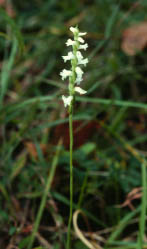

Higher Taxon
(Mabberley, 1987)
Family: Orchidaceae
Description
According to Duncan and Foote, Spiranthes
is "a variable genus, with plants often difficult to name to species.
The generic name means 'coil flower' in allusion to the spiral arrangement
of the flowers of many species"(Duncan & Foote, 1975).
Fanfani and Rossi describe the genus
Spiranthes to be,
Species ListMedium-small terrestrial plants with fibrous or tuberous roots. Approximately 300 species are ascribed to this somewhat polymorphous genus, although its precise character is still a source of systematic controversy. The leaves, variable in shape, are as a rule arranged in the form of a basal rosette; they are either persistent or caducous, present or absent during flowering, sometimes bractiform. The stiff, erect, fairly long inflorescence is composed of numerous tubular flowers that are quite small. These vary in color although they are usually greenish-white and arranged in a spiral. These lants grow freely in fields, meadows and savannas but are also found in woods and forests, both on acid and calcareous soil (Fanfani & Rossi, 1988).
S. aestivalis - Summer Ladies' Tresses
S. casei - Case's Ladies' Tresses
S. cernua - Nodding Ladies' Tresses
S. gracilis - Slender Ladies' Tresses
S. grayi - Little Ladies' Tresses
S. lacera - Slender Ladies' Tresses
S. lucida - Shining Ladies' Tresses
S. laciniata - Lace-lip Ladies' Tresses
S. longilabris - Long-lip Ladies' Tresses
S. magnicamporum - Great Plains Ladies' Tresses
S. ochroleuca - Yellow Nodding Ladies' Tresses
S. ovalis - Oval Ladies' Tresses
S. praecox - Grass-leaved Ladies' Tresses
S. romanzoffiana - Hooded Ladies' Tresses
S. sinensis - Pink Ladies' Tresses
S. spiralis - Autumn Ladies' Tresses
S. tuberosa - Beck's Tresses
S. vernalis - Spring Ladies' Tresses
This list was compiled from a number of sources (Chapman,
1997) (Gupton & Swope, 1986)
(Davies & Huxley, 1983) (Smith,
1993). Gupton and Swope list nine species, Chapman lists five,
Davies and Huxley list three, and Smith lists one.
Identification Guide
One major characteristic of
this genus is the confusing similarity that exists between the species
(Chapman, 1997). Included below is a key to
assist in species identification however Chapman gives some words of caution:
"any key to this genus automatically will be flawed by the nature of the
orchids observed. Every characteristic used here is variable to some
degree, and those attributes that are described must be understood to represent
the majority of specimens existing in their preferred habitats"(Chapman,
1997).
Just as the key that follows, most Spiranthes keys
are usually based on whether the flowers are single-ranked or multi-ranked
on the stem (Chapman, 1997).
Key to Spiranthes: Please
see extended key in Chapman's, Orchids of the Northeast
p.69-70 (Chapman, 1997).
S. cernua has slender long leaves with a distinct
base, most growing from the base of the stem. The lip is typically
white to white with a yellowish center (Chapman, 1997).
"This species has several spirals forming a dense spike
with flowers usually in 3 longitudinal rows. The lip is 6-14 mm long
and has 2 small rounded projections at its base. The longest leaves
are near the base of the stem and at most are 25 cm long" (Duncan
& Foote, 1975).
S. vernalis has basal and erect leaves, up to 30
cm long and 1 cm wide. Their upper parts tend to be covered with
fine dense pointed hairs. The stem, ovulary, and bracts are densely
and finely hairy (glandless hairs). The flowers are strongly spiraled
and the lip is usually 4.5 - 8 mm long, and widest near the base (Duncan
& Foote, 1975).
General Information
Spiranthes
has a nearly continuous distribution around the Northern Hemisphere.
Most species are mobile and tend to have weed-like tendencies. For
example, many species of Spiranthes are scarce and localized in
undisturbed areas but grow in plethora in disturbed areas - colonizers.
(Dressler, 1981)
Mabberley, D.J. 1987. The Plant Book. Cambridge University Press. Cambridge, Massachusetts.
Fanfani, Alberto and Walter Rossi. 1988. Simon & Schuster's Guide to Orchids. Simon & Schuster Inc. New York, New York.
Gupton, Oscar W. and Fred C. Swope. 1986. Wild Orchids of the Middle Atlantic States. University of Tennessee Press. Knoxville, Tennessee.
Chapman, William K. 1997. Orchids of the Northeast - A Field Guide. Syracuse University Press. Syracuse, New York.
Davies, Paule & Jenne, and Anthony Huxley. 1983. Wild Orchids of Britain and Europe. Chatto & Windus - The Hogarth Press. London, England.
Dressler, Robert L. 1981. The Orchids - Natural History and Classification. Harvard University Press. Cambridge, Massachusetts & London, England.
Cullen, J. 1992. The Orchid Book: A guide to the identification of cultivated orchid species. Cambridge University Press. Cambridge.
Bulat, Thomas J. and Marilyn Bulat. 1995. Hidden Orchids. Rudi Publishing. Iowa City.
Duncan, Wilbur H. and Leonard E. Foote. 1975. Wildflowers of the Southeastern United States. University of Georgia Press. Athens, Georgia.
Smith, Welby R. 1993. Orchids of Minnesota. University of Minnesota Press. Minneapolis, Minnesota.
University of Georgia Herbarium,
Athens, Georgia.
Cronquist, Arthur. 1981. An
Integrated System of Classification of Flowering Plants. Columbia
University Press. New York.
Jones, Samuel B. Jr., and Nancy Craft Coile. 1988. The Distribution of the Vascular Flora of Georgia. Dept. of Botany. University of Georgia. Athens, Georgia.
Chester, Edward, B. Eugene Wafford, Robert Kral, Hal R. Deselam, A. Murray Evans. 1993. Atlas of Tennessee Vascular Plants. Austin Peay State University. Clarksville, Tennessee.
Acknowledgements
Many thanks to:
- Patrick
Sweeney & Mike Moore for orienting me to the UGA Herbarium.
- UGA Herbarium
for providing me with slides and reference books.
- Beth Shapiro
for scanning my slides for my page.
- Elizabeth
Skillen for answering ALL my silly questions.
- Anupam Jaju
for assisting me in my web page design.